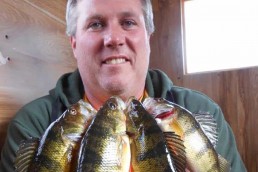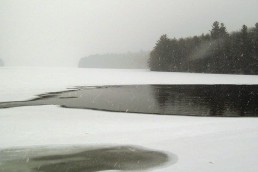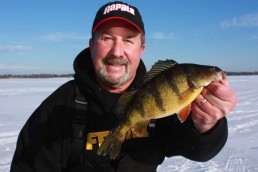Special Trick Reveals Color Preference of Late-ice Perch
SHARE THIS POST
We are working the mud flats. Yes—the mud flats in the area we are fishing is our best location and yours, if your lake is shallow and weedy.
At this time of year the perch are feeding heavily on tiny mayfly larvae and other aquatic insect larvae that are located at the deeper silt areas of the lake. These areas are not necessarily the deepest parts of the lake, but are areas connected to sandbars or the deepest areas of rock bars, or are connected to deep weedy bays.
These perch are very aggressive and are easily caught. We simply adjust to their needs.
Wow. What does that mean to us, the fisherman? Well, it’s like this: We first have to locate the fish. We do this with our GPS coordinates from late fall, where we were catching them. Next, we use our underwater cameras. After locating the fish, we send down a multiple array of unbaited, colored hooks and try to catch the perch.
That’s right. Non-live baited hooks. I do this in conjunction with an underwater camera, because I want to discover what color the perch will be attracted to, and which colors they swim away from. This method of trial and error works incredibly well. For example, we see fish repeatedly bite the lure or jig head before they even touch the live bait, which, this indicates to you, the fisherman, that you have discovered what color works best in the water clarity you are currently fishing.
Are you enjoying this post?
You can be among the first to get the latest info on where to go, what to use and how to use it!
This discovery will increase your catch ratio by 10 fold. This works, wherever you fish. Once we have discovered this perfect color, we then load our hooks with tiny 3/4-inch sized minnows, waxworms, mousses or wigglers—these live baits produce well. Working the bait aggressively can produce violent strikes, and then if we simply allow the minnow to swim without moving the hook, this will also produce an aggressive strike.
We need to discover which motions and what level of vibration creates a strike or scares the fish. This is easily done with the underwater camera. If you do not own one, you need to get one. A camera (if water clarity allows it) will teach you more in one day than a flasher will teach you in a year. Just ask anyone who owns a “current” underwater camera; the newer models have a very clear picture. The camera is a learning tool that requires very little transition from a flasher. In dark-stained water, you will still need a flasher, as the camera will not work well in only a few inches of visibility.
Fishing on the flat areas of the lake produce well for perch this time of year. And we do not want to fish the deepest water, but the deeper-averaged depths and along the bottom. If we can find a 2-foot difference in the bottom depth, this will hold hundreds of perch. Remember, we need to be fishing a lake that is known for perch, just as there are certain lakes that are known for good walleye fishing or those known to have multiple species in them. We like to use 2-pound mono for our line and tiny number 14 treble hooks or tiny single hooks when hooking our minnows.
Remember, color will also make a difference in your catch ratio for your hooks, spoon or jig head.
John Andrew is the owner/operator of The Anglers Choice Guide Service located in northern Wisconsin and he can be reached at 715-892-3020, 715-686-2012 or johnandrew@centurytel.net or theanglerschoiceguideservice.com.
MWO
SHARE THIS POST
Did you enjoy this post?
You can be among the first to get the latest info on where to go, what to use and how to use it!
John Andrew
John Andrew is the owner/operator of The Anglers Choice Guide Service located in northern Wisconsin. He may be reached at 715-892-3020, 715-686-2012 or johnandrew@centurytel.net or theanglerschoiceguideservice.com.



